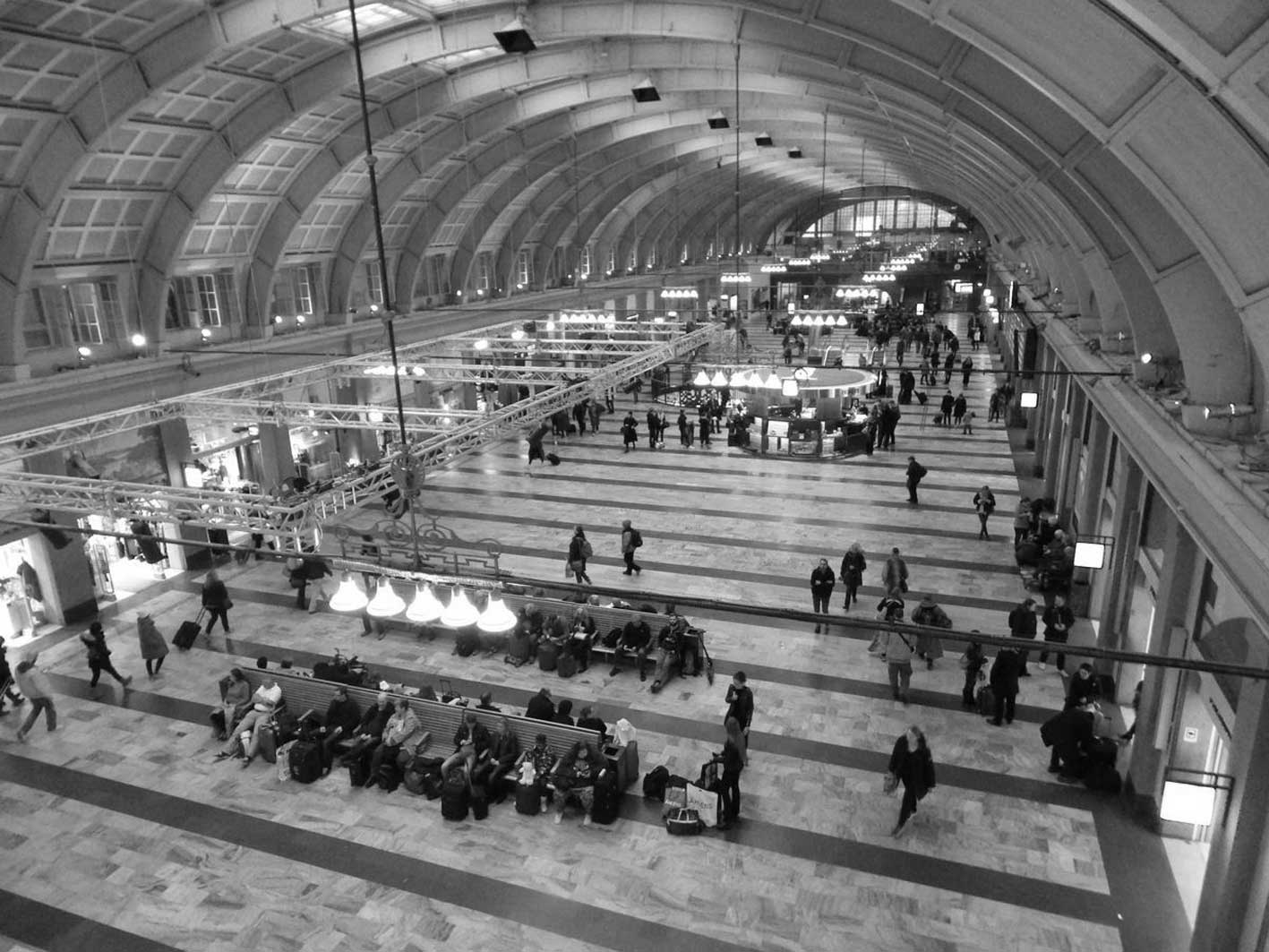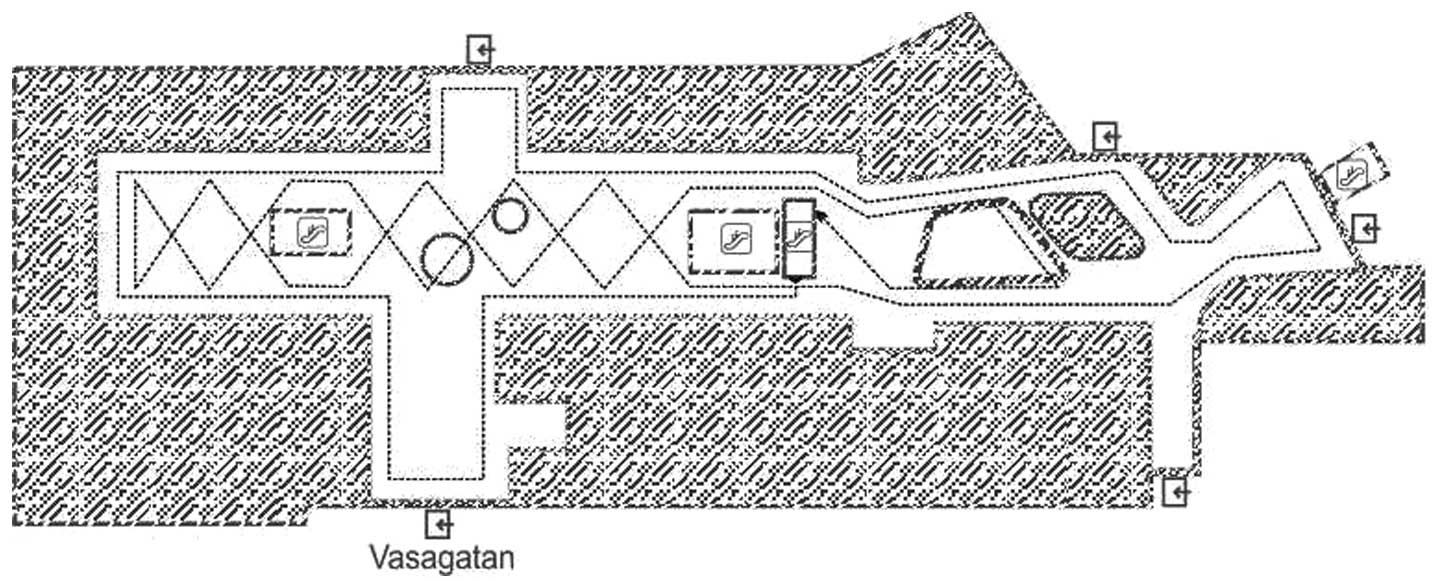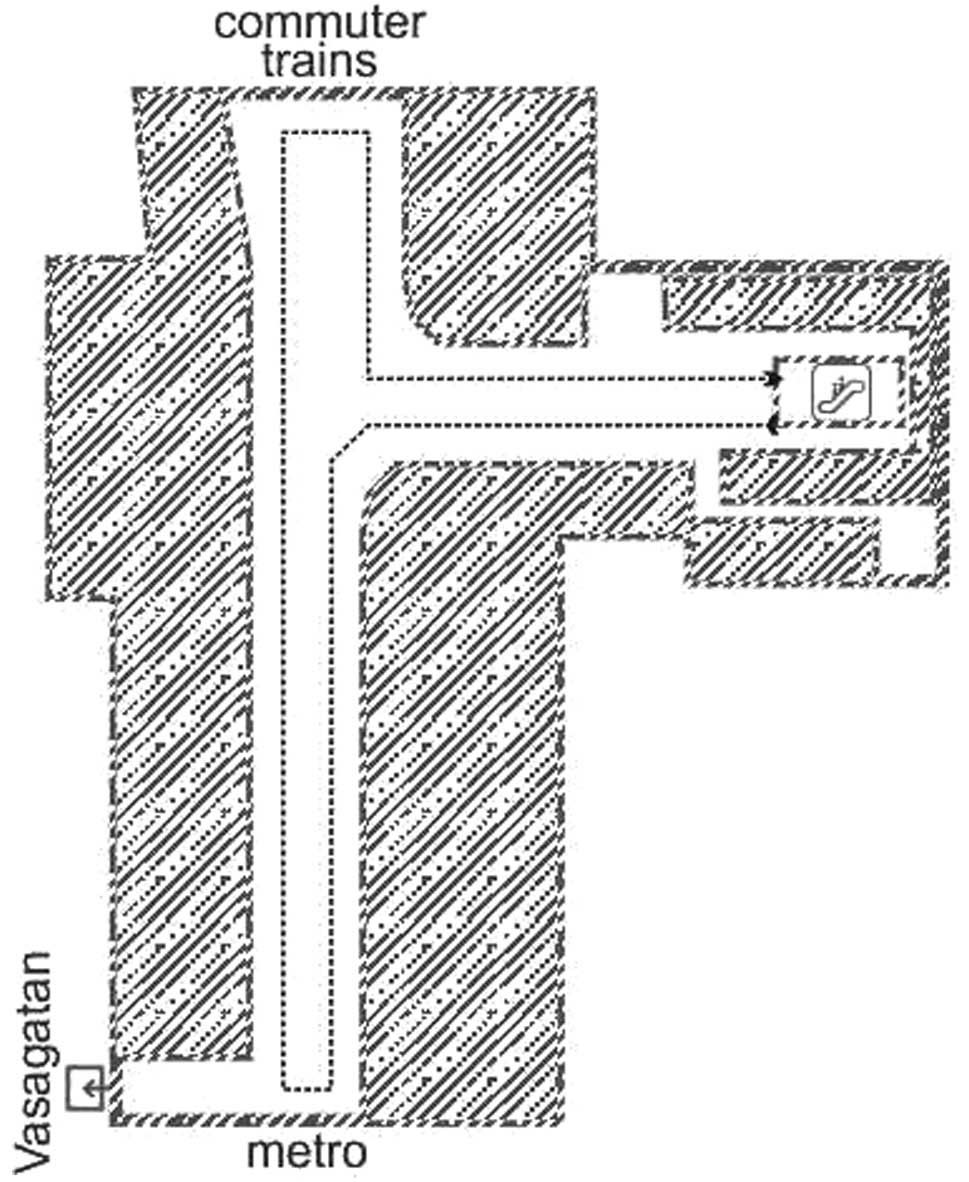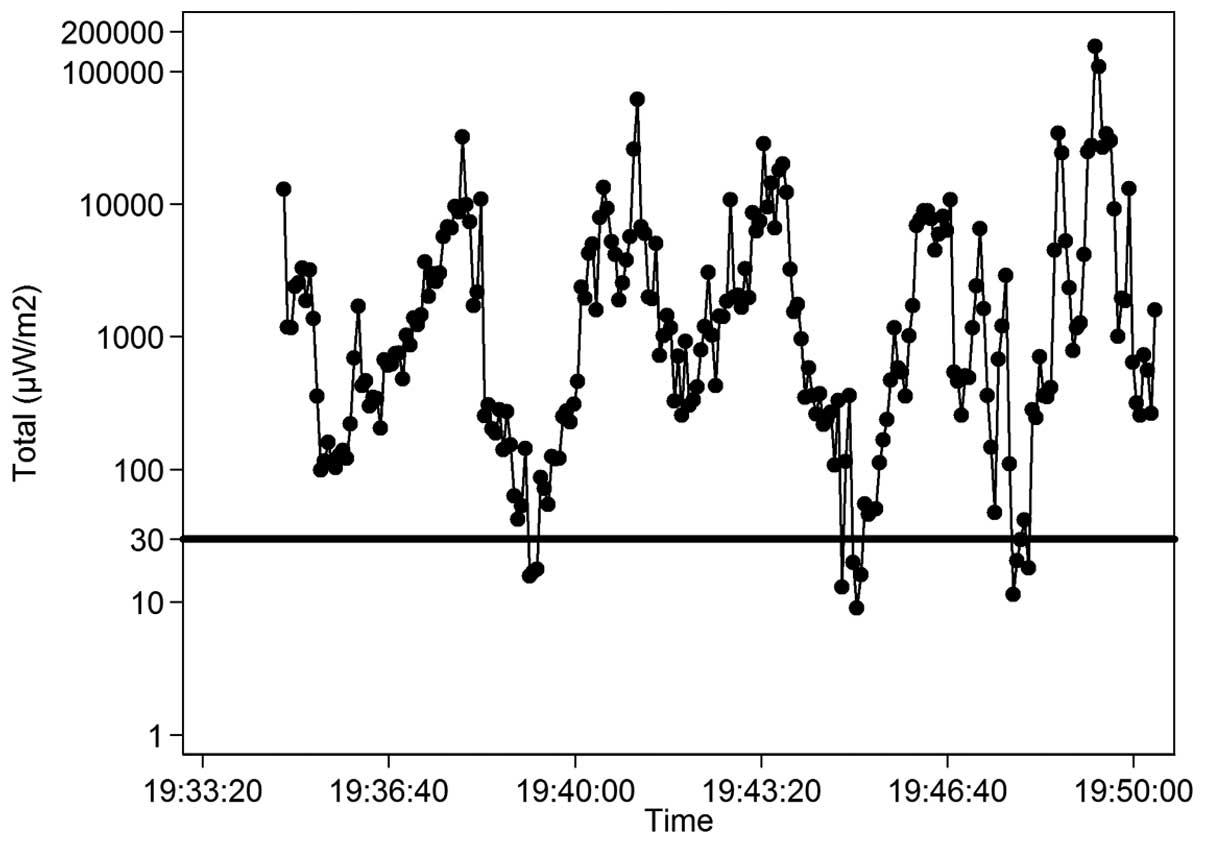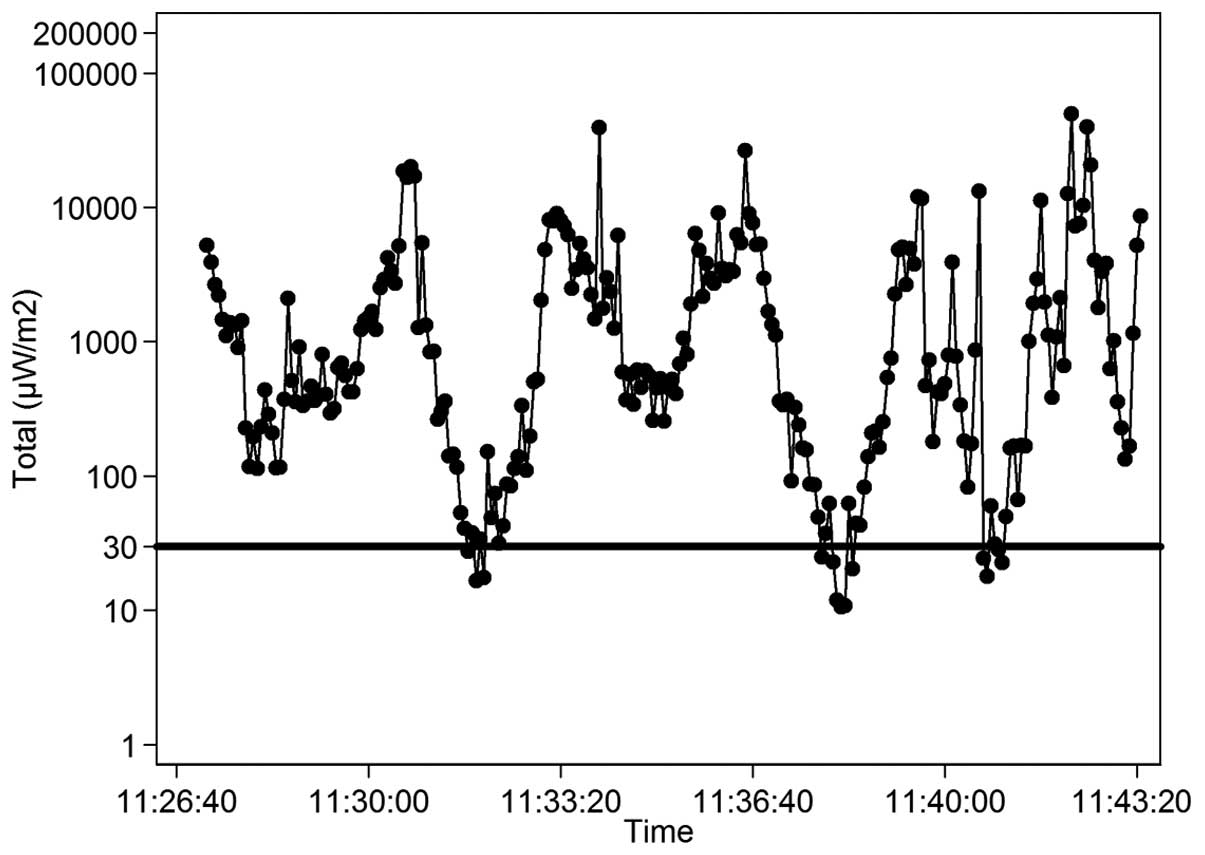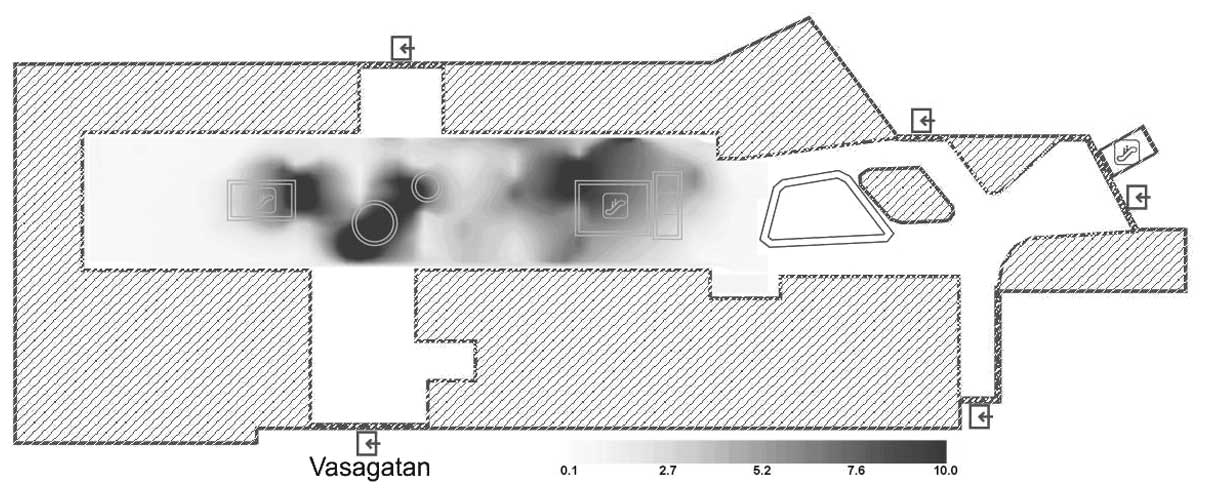|
1
|
Baan R, Grosse Y, Lauby-Secretan B, El
Ghissassi F, Bouvard V, Benbrahim-Tallaa L, Guha N, Islami F,
Galichet L and Straif K; WHO International Agency for Research on
Cancer Monograph Working Group. Carcinogenicity of radiofrequency
electromagnetic fields. Lancet Oncol. 12:624–626. 2011. View Article : Google Scholar : PubMed/NCBI
|
|
2
|
IARC Monographs on the Evaluation of
Carcinogenic Risks to Humans. 102:Non-Ionizing Radiation Part 2:
Radiofrequency Electromagnetic Fields. International Agency for
Research on Cancer; Lyon, France: 2013, Available online:
http://monographs.iarc.fr/ENG/Monographs/vol102/mono102.pdf.
accessed on 1 June 2016
|
|
3
|
IARC Monographs on the Evaluation of
Carcinogenic Risks to Humans. 80:Non-Ionizing Radiation, Part I:
Static and Extremely Low-Frequency (ELF) Electric and Magnetic
Fields. IARC Press; Lyon, France: 2002, Available online:
http://mono-graphs.iarc.fr/ENG/Monographs/vol80/mono80.pdf.
accessed on 1 June 2016
|
|
4
|
Hardell L, Carlberg M and Hansson Mild K:
Pooled analysis of two case-control studies on use of cellular and
cordless telephones and the risk for malignant brain tumours
diagnosed in 1997–2003. Int Arch Occup Environ Health. 79:630–639.
2006. View Article : Google Scholar : PubMed/NCBI
|
|
5
|
Hardell L, Carlberg M and Hansson Mild K:
Pooled analysis of two case-control studies on the use of cellular
and cordless telephones and the risk of benign brain tumours
diagnosed during 1997–2003. Int J Oncol. 28:509–518.
2006.PubMed/NCBI
|
|
6
|
Hardell L, Carlberg M and Hansson Mild K:
Pooled analysis of case-control studies on malignant brain tumours
and the use of mobile and cordless phones including living and
deceased subjects. Int J Oncol. 38:1465–1474. 2011. View Article : Google Scholar : PubMed/NCBI
|
|
7
|
INTERPHONE Study Group. Brain tumour risk
in relation to mobile telephone use: Results of the INTERPHONE
international case-control study. Int J Epidemiol. 39:675–694.
2010. View Article : Google Scholar : PubMed/NCBI
|
|
8
|
INTERPHONE Study Group. Acoustic neuroma
risk in relation to mobile telephone use: Results of the INTERPHONE
international case-control study. Cancer Epidemiol. 35:453–464.
2011. View Article : Google Scholar : PubMed/NCBI
|
|
9
|
Cardis E, Armstrong BK, Bowman JD, Giles
GG, Hours M, Krewski D, McBride M, Parent ME, Sadetzki S, Woodward
A, et al: Risk of brain tumours in relation to estimated RF dose
from mobile phones: Results from five Interphone countries. Occup
Environ Med. 68:631–640. 2011. View Article : Google Scholar : PubMed/NCBI
|
|
10
|
Hardell L, Carlberg M, Söderqvist F and
Mild KH: Pooled analysis of case-control studies on acoustic
neuroma diagnosed 1997–2003 and 2007–2009 and use of mobile and
cordless phones. Int J Oncol. 43:1036–1044. 2013.PubMed/NCBI
|
|
11
|
Hardell L, Carlberg M, Söderqvist F and
Mild KH: Case-control study of the association between malignant
brain tumours diagnosed between 2007 and 2009 and mobile and
cordless phone use. Int J Oncol. 43:1833–1845. 2013.PubMed/NCBI
|
|
12
|
Hardell L, Carlberg M and Hansson Mild K:
Use of mobile phones and cordless phones is associated with
increased risk for glioma and acoustic neuroma. Pathophysiology.
20:85–110. 2013. View Article : Google Scholar
|
|
13
|
Hardell L and Carlberg M: Mobile phone and
cordless phone use and the risk for glioma - Analysis of pooled
case-control studies in Sweden, 1997–2003 and 2007–2009.
Pathophysiology. 22:1–13. 2015. View Article : Google Scholar
|
|
14
|
Coureau G, Bouvier G, Lebailly P,
Fabbro-Peray P, Gruber A, Leffondre K, Guillamo JS, Loiseau H,
Mathoulin-Pélissier S, Salamon R, et al: Mobile phone use and brain
tumours in the CERENAT case-control study. Occup Environ Med.
71:514–522. 2014. View Article : Google Scholar : PubMed/NCBI
|
|
15
|
Lerchl A, Klose M, Grote K, Wilhelm AF,
Spathmann O, Fiedler T, Streckert J, Hansen V and Clemens M: Tumor
promotion by exposure to radiofrequency electromagnetic fields
below exposure limits for humans. Biochem Biophys Res Commun.
459:585–590. 2015. View Article : Google Scholar : PubMed/NCBI
|
|
16
|
Tillmann T, Ernst H, Streckert J, Zhou Y,
Taugner F, Hansen V and Dasenbrock C: Indication of cocarcinogenic
potential of chronic UMTS-modulated radiofrequency exposure in an
ethylnitrosourea mouse model. Int J Radiat Biol. 86:529–541. 2010.
View Article : Google Scholar : PubMed/NCBI
|
|
17
|
Repacholi MH, Basten A, Gebski V, Noonan
D, Finnie J and Harris AW: Lymphomas in E mu-Pim1 transgenic mice
exposed to pulsed 900 MHZ electromagnetic fields. Radiat Res.
147:631–640. 1997. View Article : Google Scholar : PubMed/NCBI
|
|
18
|
Wyde M, Cesta M, Blystone C, Elmore S,
Foster P, Hooth M, Kissling G, Malarkey D, Sills R, Stout M, et al:
Report of Partial Findings from the National Toxicology Program
Carcinogenesis Studies of Cell Phone Radiofrequency Radiation in
Hsd: Sprague Dawley® SD rats (Whole Body Exposures). Draft
5-19-2016. US National Toxicology Program (NTP); 2016, http://dx.doi.org/http://dx.doi.org/10.1101/055699.
Available online: http://biorxiv.org/content/biorxiv/early/2016/05/26/055699.full.pdf.
accessed on 1 June 2016
|
|
19
|
Khurana VG, Hardell L, Everaert J,
Bortkiewicz A, Carlberg M and Ahonen M: Epidemiological evidence
for a health risk from mobile phone base stations. Int J Occup
Environ Health. 16:263–267. 2010. View Article : Google Scholar : PubMed/NCBI
|
|
20
|
International Commission on Non-Ionizing
Radiation Protection. Guidelines for limiting exposure to
time-varying electric, magnetic, and electromagnetic fields (up to
300 GHz). Health Phys. 74:494–522. 1998.
|
|
21
|
International Commission on Non-Ionizing
Radiation Protection. ICNIRP statement on the ‘Guidelines for
limiting exposure to time-varying electric, magnetic, and
electromagnetic fields (up to 300 GHz)’. Health Phys. 97:257–258.
2009. View Article : Google Scholar
|
|
22
|
International Commission on Non-Ionizing
Radiation Protection. General approach to protection against
non-ionizing radiation. Health Phys. 82:540–548. 2002. View Article : Google Scholar : PubMed/NCBI
|
|
23
|
Gandhi OP, Morgan LL, de Salles AA, Han
YY, Herberman RB and Davis DL: Exposure limits: The underestimation
of absorbed cell phone radiation, especially in children.
Electromagn Biol Med. 31:34–51. 2012. View Article : Google Scholar
|
|
24
|
Hedendahl L, Carlberg M and Hardell L:
Electromagnetic hypersensitivity - an increasing challenge to the
medical profession. Rev Environ Health. 30:209–215. 2015.
View Article : Google Scholar
|
|
25
|
BioInitiative Working Group. BioInitiative
Report: A Rationale for a Biologically-based Public Exposure
Standard for Electromagnetic Fields (ELF and RF). Sage C and
Carpenter DO: Bioinitiative. 2007, Available online: http://www.bioinitiative.org/table-of-contents/.
accessed on 1 June 2016
|
|
26
|
BioInitiative Working Group. BioInitiative
2012. A Rationale for a Biologically-based Public Exposure Standard
for Electromagnetic Fields (ELF and RF). Sage C and Carpenter DO:
Bioinitiative. 2012, Available online: http://www.bioinitiative.org/table-of-contents/.
accessed on 1 June 2016
|
|
27
|
Thomas S, Kühnlein A, Heinrich S, Praml G,
Nowak D, von Kries R and Radon K: Personal exposure to mobile phone
frequencies and well-being in adults: A cross-sectional study based
on dosimetry. Bioelectromagnetics. 29:463–470. 2008. View Article : Google Scholar : PubMed/NCBI
|
|
28
|
Thomas S, Heinrich S, von Kries R and
Radon K: Exposure to radio-frequency electromagnetic fields and
behavioural problems in Bavarian children and adolescents. Eur J
Epidemiol. 25:135–141. 2010. View Article : Google Scholar
|
|
29
|
Heinrich S, Thomas S, Heumann C, von Kries
R and Radon K: Association between exposure to radiofrequency
electromagnetic fields assessed by dosimetry and acute symptoms in
children and adolescents: A population based cross-sectional study.
Environ Health. 9:752010. View Article : Google Scholar : PubMed/NCBI
|
|
30
|
Buchner K and Eger H: Changes of
clinically important neurotransmitters under the influence of
modulated RF fields: A long-term study under real-life conditions.
Umwelt-Medizin-Gesellschaft. 24:44–57. 2011.(In German).
|
|
31
|
Estenberg J and Augustsson T: Extensive
frequency selective measurements of radiofrequency fields in
outdoor environments performed with a novel mobile monitoring
system. Bioelectromagnetics. 35:227–230. 2014. View Article : Google Scholar : PubMed/NCBI
|
|
32
|
Gryz K, Karpowicz J, Leszko W and
Zradziński P: Evaluation of exposure to electromagnetic
radiofrequency radiation in the indoor workplace accessible to the
public by the use of frequency-selective exposimeters. Int J Occup
Med Environ Health. 27:1043–1054. 2014. View Article : Google Scholar : PubMed/NCBI
|
|
33
|
Gryz K and Karpowicz J: Radiofrequency
electromagnetic radiation exposure inside the metro tube
infrastructure in Warszawa. Electromagn Biol Med. 34:265–273. 2015.
View Article : Google Scholar : PubMed/NCBI
|
|
34
|
Bolte JF and Eikelboom T: Personal
radiofrequency electromagnetic field measurements in The
Netherlands: Exposure level and variability for everyday
activities, times of day and types of area. Environ Int.
48:133–142. 2012. View Article : Google Scholar : PubMed/NCBI
|
|
35
|
Hamnerius Y and Uddmar T: Microwave
exposure from mobile phones and base stations in Sweden.
Proceedings of the International Conference on Cell Tower Sitting.
pp. 52–63. 2000, Available online: https://www.salzburg.gv.at/gesundheit_/Documents/proceedings_(08)_hamnerius.pdf.
accessed on 1 June 2016
|
|
36
|
Foster KR: Radiofrequency exposure from
wireless LANs utilizing Wi-Fi technology. Health Phys. 92:280–289.
2007. View Article : Google Scholar : PubMed/NCBI
|
|
37
|
Bhatt CR, Thielens A, Redmayne M, Abramson
MJ, Billah B, Sim MR, Vermeulen R, Martens L, Joseph W and Benke G:
Measuring personal exposure from 900MHz mobile phone base stations
in Australia and Belgium using a novel personal distributed
exposimeter. Environ Int. 92–93:388–397. 2016. View Article : Google Scholar
|
|
38
|
Bolte JF, Maslanyj M, Addison D, Mee T,
Kamer J and Colussi L: Do car-mounted mobile measurements used for
radio-frequency spectrum regulation have an application for
exposure assessments in epidemiological studies? Environ Int.
86:75–83. 2016. View Article : Google Scholar
|
|
39
|
Eberhardt JL, Persson BR, Brun AE, Salford
LG and Malmgren LO: Blood-brain barrier permeability and nerve cell
damage in rat brain 14 and 28 days after exposure to microwaves
from GSM mobile phones. Electromagn Biol Med. 27:215–229. 2008.
View Article : Google Scholar : PubMed/NCBI
|
|
40
|
Salford LG, Brun AE, Eberhardt JL,
Malmgren L and Persson BR: Nerve cell damage in mammalian brain
after exposure to microwaves from GSM mobile phones. Environ Health
Perspect. 111:881–883; discussion A408. 2003. View Article : Google Scholar : PubMed/NCBI
|
|
41
|
Nittby H, Brun A, Eberhardt J, Malmgren L,
Persson BR and Salford LG: Increased blood-brain barrier
permeability in mammalian brain 7 days after exposure to the
radiation from a GSM-900 mobile phone. Pathophysiology. 16:103–112.
2009. View Article : Google Scholar : PubMed/NCBI
|
|
42
|
Sırav B and Seyhan N: Effects of GSM
modulated radio-frequency electromagnetic radiation on permeability
of blood-brain barrier in male & female rats. J Chem Neuroanat.
Dec 23–2015.pii: S0891-0618(15)00106-4. View Article : Google Scholar : (Epub ahead of
print).
|
|
43
|
Tang J, Zhang Y, Yang L, Chen Q, Tan L,
Zuo S, Feng H, Chen Z and Zhu G: Exposure to 900 MHz
electromagnetic fields activates the mkp-1/ERK pathway and causes
blood-brain barrier damage and cognitive impairment in rats. Brain
Res. 1601:92–101. 2015. View Article : Google Scholar : PubMed/NCBI
|
|
44
|
Nittby H, Grafström G, Tian DP, Malmgren
L, Brun A, Persson BR, Salford LG and Eberhardt J: Cognitive
impairment in rats after long-term exposure to GSM-900 mobile phone
radiation. Bioelectromagnetics. 29:219–232. 2008. View Article : Google Scholar
|
|
45
|
Grafström G, Nittby H, Brun A, Malmgren L,
Persson BR, Salford LG and Eberhardt J: Histopathological
examinations of rat brains after long-term exposure to GSM-900
mobile phone radiation. Brain Res Bull. 77:257–263. 2008.
View Article : Google Scholar : PubMed/NCBI
|
|
46
|
Gerner C, Haudek V, Schandl U, Bayer E,
Gundacker N, Hutter HP and Mosgoeller W: Increased protein
synthesis by cells exposed to a 1,800-MHz radio-frequency mobile
phone electromagnetic field, detected by proteome profiling. Int
Arch Occup Environ Health. 83:691–702. 2010. View Article : Google Scholar : PubMed/NCBI
|
|
47
|
Markovà E, Malmgren LO and Belyaev IY:
Microwaves from mobile phones inhibit 53BP1 focus formation in
human stem cells more strongly than in differentiated cells:
Possible mechanistic link to cancer risk. Environ Health Perspect.
118:394–399. 2010.PubMed/NCBI
|
|
48
|
Fragopoulou AF, Samara A, Antonelou MH,
Xanthopoulou A, Papadopoulou A, Vougas K, Koutsogiannopoulou E,
Anastasiadou E, Stravopodis DJ, Tsangaris GT, et al: Brain proteome
response following whole body exposure of mice to mobile phone or
wireless DECT base radiation. Electromagn Biol Med. 31:250–274.
2012. View Article : Google Scholar : PubMed/NCBI
|
|
49
|
Dasdag S, Akdag MZ, Erdal ME, Erdal N, Ay
OI, Ay ME, Yilmaz SG, Tasdelen B and Yegin K: Effects of 2.4 GHz
radio-frequency radiation emitted from Wi-Fi equipment on microRNA
expression in brain tissue. Int J Radiat Biol. 91:555–561. 2015.
View Article : Google Scholar : PubMed/NCBI
|
|
50
|
Dasdag S, Taş M, Akdag MZ and Yegin K:
Effect of long-term exposure of 2.4 GHz radiofrequency radiation
emitted from Wi-Fi equipment on testes functions. Electromagn Biol
Med. 34:37–42. 2015. View Article : Google Scholar
|
|
51
|
Avendaño C, Mata A, Sanchez Sarmiento CA
and Doncel GF: Use of laptop computers connected to internet
through Wi-Fi decreases human sperm motility and increases sperm
DNA fragmentation. Fertil Steril. 97:39–45.e2. 2012. View Article : Google Scholar
|
|
52
|
Atasoy HI, Gunal MY, Atasoy P, Elgun S and
Bugdayci G: Immunohistopathologic demonstration of deleterious
effects on growing rat testes of radiofrequency waves emitted from
conventional Wi-Fi devices. J Pediatr Urol. 9:223–229. 2013.
View Article : Google Scholar
|
|
53
|
Akdag MZ, Dasdag S, Canturk F, Karabulut
D, Caner Y and Adalier N: Does prolonged radiofrequency radiation
emitted from Wi-Fi devices induce DNA damage in various tissues of
rats? J Chem Neuroanat. Jan 8–2016.pii: S0891-0618(16)00005-3.
View Article : Google Scholar : (Epub ahead of
print). PubMed/NCBI
|
|
54
|
Yakymenko I, Tsybulin O, Sidorik E,
Henshel D, Kyrylenko O and Kyrylenko S: Oxidative mechanisms of
biological activity of low-intensity radiofrequency radiation.
Electromagn Biol Med. 19:1–17. 2015.
|
|
55
|
Burlaka A, Tsybulin O, Sidorik E, Lukin S,
Polishuk V, Tsehmistrenko S and Yakymenko I: Overproduction of free
radical species in embryonal cells exposed to low intensity
radio-frequency radiation. Exp Oncol. 35:219–225. 2013.PubMed/NCBI
|
|
56
|
Megha K, Deshmukh PS, Banerjee BD,
Tripathi AK and Abegaonkar MP: Microwave radiation induced
oxidative stress, cognitive impairment and inflammation in brain of
Fischer rats. Indian J Exp Biol. 50:889–896. 2012.
|
|
57
|
Megha K, Deshmukh PS, Banerjee BD,
Tripathi AK, Ahmed R and Abegaonkar MP: Low intensity microwave
radiation induced oxidative stress, inflammatory response and DNA
damage in rat brain. Neurotoxicology. 51:158–165. 2015. View Article : Google Scholar : PubMed/NCBI
|
|
58
|
Deshmukh PS, Nasare N, Megha K, Banerjee
BD, Ahmed RS, Singh D, Abegaonkar MP, Tripathi AK and Mediratta PK:
Cognitive impairment and neurogenotoxic effects in rats exposed to
low-intensity microwave radiation. Int J Toxicol. 34:284–290. 2015.
View Article : Google Scholar : PubMed/NCBI
|
|
59
|
Megha K, Deshmukh PS, Ravi AK, Tripathi
AK, Abegaonkar MP and Banerjee BD: Effect of low-intensity
microwave radiation on monoamine neurotransmitters and their key
regulating enzymes in rat brain. Cell Biochem Biophys. 73:93–100.
2015. View Article : Google Scholar : PubMed/NCBI
|
|
60
|
Deshmukh PS, Banerjee BD, Abegaonkar MP,
Megha K, Ahmed RS, Tripathi AK and Mediratta PK: Effect of low
level microwave radiation exposure on cognitive function and
oxidative stress in rats. Indian J Biochem Biophys. 50:114–119.
2013.PubMed/NCBI
|
|
61
|
Hardell L and Carlberg M: Using the Hill
viewpoints from 1965 for evaluating strengths of evidence of the
risk for brain tumors associated with use of mobile and cordless
phones. Rev Environ Health. 28:97–106. 2013. View Article : Google Scholar : PubMed/NCBI
|
|
62
|
Urbinello D, Joseph W, Verloock L, Martens
L and Röösli M: Temporal trends of radio-frequency electromagnetic
field (RF-EMF) exposure in everyday environments across European
cities. Environ Res. 134:134–142. 2014. View Article : Google Scholar : PubMed/NCBI
|
|
63
|
Frei P, Mohler E, Neubauer G, Theis G,
Bürgi A, Fröhlich J, Braun-Fahrländer C, Bolte J, Egger M and
Röösli M: Temporal and spatial variability of personal exposure to
radio frequency electromagnetic fields. Environ Res. 109:779–785.
2009. View Article : Google Scholar : PubMed/NCBI
|
|
64
|
Bolte JF, van der Zande G and Kamer J:
Calibration and uncertainties in personal exposure measurements of
radiofrequency electromagnetic fields. Bioelectromagnetics.
32:652–663. 2011. View Article : Google Scholar : PubMed/NCBI
|
|
65
|
Rowley JT and Joyner KH: Comparative
international analysis of radiofrequency exposure surveys of mobile
communication radio base stations. J Expo Sci Environ Epidemiol.
22:304–315. 2012. View Article : Google Scholar : PubMed/NCBI
|
|
66
|
Markakis I and Samaras T: Radiofrequency
exposure in Greek indoor environments. Health Phys. 104:293–301.
2013. View Article : Google Scholar : PubMed/NCBI
|
|
67
|
Viel JF, Tiv M, Moissonnier M, Cardis E
and Hours M: Variability of radiofrequency exposure across days of
the week: A population-based study. Environ Res. 111:510–513. 2011.
View Article : Google Scholar : PubMed/NCBI
|
|
68
|
Joseph W, Frei P, Roösli M, Thuróczy G,
Gajsek P, Trcek T, Bolte J, Vermeeren G, Mohler E, Juhász P, et al:
Comparison of personal radio frequency electromagnetic field
exposure in different urban areas across Europe. Environ Res.
110:658–663. 2010. View Article : Google Scholar : PubMed/NCBI
|
|
69
|
Tell RA and Kavet R: A survey of the urban
radiofrequency (RF) environment. Radiat Prot Dosimetry.
162:499–507. 2014. View Article : Google Scholar : PubMed/NCBI
|



